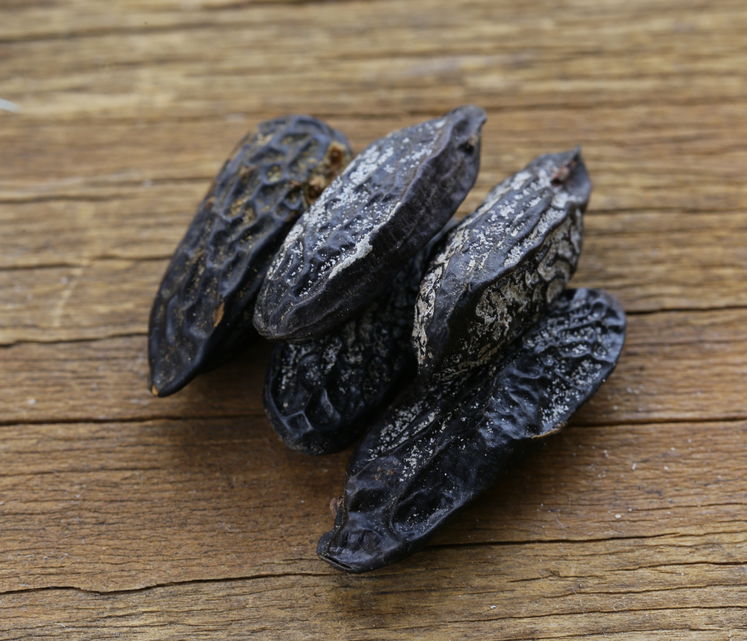Tonka Bean Tree

Common Names: Tonka beans, Tonka, tonkin beans, tonquin beans, cumaru, kumaru, Dutch Tonka, Torquin, almendrillo negro, Brazilian Teak, fève tonka, haba tonka, Cimaru, Choiba, Sarrapia, Gaiac, Guayac, Karapa Bossi, tongo tongo, Dipteryx odorata, Dipteryx oppositifolia, Coumarouna
Latin Name: Dipteryx odorata
Origin: South America
Short Introduction
Cultivation:
Today, commercial cultivation of Tonka Bean Trees is common in countries like Venezuela and Nigeria. The tree thrives in poor, well-drained soils with a preferred pH range of 5.5 to 6.5. Each tree can yield 0.5–1 kg of beans, although some sources report up to 25 kg under optimal conditions. Remarkably, the tree bears fruit only once every 2–3 years.
The best growth occurs in fertile, humus-rich soil, preferably at temperatures between 22–30°C, though the tree tolerates up to 34°C and annual rainfall between 2,000 and 2,500 mm. It prefers full sun or partial shade.
Fresh fruits are harvested in June and July, with fallen pods collected between January and March (sometimes earlier). The hard shell is removed, the beans are scattered and left to dry for 2 days. Venezuela is the largest producer, followed by Brazil and Colombia. The United States is the primary importer, mainly for the tobacco industry.
Detailed Description
Tonka beans are aromatic seeds prized for their unique properties and captivating scent.
Botanical Information
The Tonka Bean Tree, botanically known as Dipteryx odorata, is an evergreen tree that typically reaches heights of 25–30 meters, with some specimens reported as tall as 50 meters. The trunk may be up to 1 meter in diameter, occasionally remaining branchless for up to 20 meters. The tree is recognized for its rounded crown, smooth grayish bark, and attractive red wood. Its leaves are alternate, lanceolate, leathery, and dark green, typically growing in clusters of 3–6. Pink flowers appear between March and May, while each fruit contains a single seed, and the tree bears fruit from June to July.
The beans have a smooth but wrinkled dark exterior, while the inside displays a brown coloration. Their strong, woody, sweet aroma is attributed to a high concentration of coumarins.
Origin and Distribution
The Tonka Bean Tree is native to Central America and the northern regions of South America. While it grows naturally in these native areas, it has also been introduced to Africa for commercial cultivation.
Usage / Dosage
The Tonka Bean Tree is an important local resource and valued for more than just its seeds. The pulp of its beans is eaten fresh, while seeds are generally boiled before consumption.
Historically, tonka beans played a significant role in perfumery and the tobacco industry as a vanilla substitute, although usage in food was later prohibited. Nonetheless, tonka extract remains popular among fragrance producers such as Yves Rocher. Culinary uses of tonka persist in French cuisine, especially in select sauces and desserts. The durable and fire-resistant wood, naturally colored, has also become increasingly popular in the U.S. for flooring material.
Due to its coumarin content, the use of tonka beans in food is regulated by the U.S. FDA, since some anticoagulant drugs (like warfarin) are coumarin derivatives. However, coumarin alone does not have blood-thinning effects.
Traditional Medicine
The bark is used locally as an astringent and febrifuge. Decoctions made from the plant, sometimes combined with other herbs, are administered to help strengthen children. Thanks to its coumarins, the beans are traditionally used in folk medicine as an anti-asthmatic, anti-tubercular agent, and are also employed against cramps, as a cardiotonic, and as an emmenagogue.
Folk remedies recommend the Tonka Bean Tree for conditions such as coughs, diarrheal issues, and schistosomiasis. A decoction of the seeds is used as a cold remedy. Healers prepare tinctures of seed decoction mixed with rum, applied topically for snake bites, bruises, and rheumatic problems.
The pressed oil from seeds is used to relieve stomach pain, treat mouth ulcers and canker sores, promote hair growth, and even for dysentery. A cold infusion of the seeds is sometimes used as an earwash for earache or as a gargle for sore throat and throat discomfort.
Animal Studies
Research in animal models has revealed that isoliquiritigenin isolated from Tonka Bean Tree seeds can increase quinone reductase activity in Hepa1c1c7 cells and inhibit preneoplastic lesion formation in animals treated with certain carcinogens. Similar effects were described for components like methoxyauron, sulfuretin, and balanophonin. No clinical (human) studies have confirmed these effects yet.
Toxicity / Overdose
Excessive intake of coumarins may result in bleeding, liver problems, and cardiovascular system paralysis. Toxic effects in animals were observed at doses of 350 mg/kg of extract.
Active Compounds
Tonka beans are rich in coumarins—the basis for several traditional names (the plant is also known as "cumaru"). Beans typically contain 1–3% coumarins, but concentrations may reach up to 10%. The coumarins lend their characteristic aroma and bitterness, also making tonka highly valued in perfumery.
Chemical analyses of the beans reveal the presence of diterpenes (such as dipteryx acid), isoflavonolignans (including 5-methoxyxanthocercin A, isoliquiritigenin, dihydroxymethoxyauron, sulfuretin, and balanophonin), as well as butin, eriodictyol, hydroxychromone, dihydroxydimethoxyisoflavone, and lariciresinol. The bark contains isoflavones and umbelliferone, and the leaves are a source of salicylic, hydroxycoumaric, coumaric, and ferulic acids.
Traditional Dosage
Medicinal usage should always consider age, patient condition, and any concurrent therapies. No specific official dosage is established, and traditional practices do not stipulate exact amounts. In the European Union, the tolerated daily intake for coumarin is 0.1 mg/kg body weight.
When used in cooking, due to their potent aroma, tonka beans should be used sparingly—a small amount suffices to flavor dishes.
